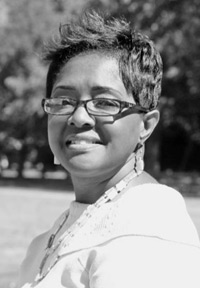Grace Clark

My name is Grace Clark and I am celebrating my 50th year of life and 10 years of survivorship.
During the summer of 1999, I began to feel an overwhelming need to switch gynecologists as I was heading to the big 40 and felt a female doctor would best serve my needs – you know, menopause. My gynecologist of 15 years was a male who delivered my children who are now 25 (son) and 21 (daughter). My medical APRN (Advanced Practice Nurse) gave me the name of one her colleagues, Sarah Njamy, who is a Clinical Nurse Midwife (RN, CNM).
I made an appointment with Sarah before my 39th birthday and my examination was unremarkable. She asked me if I had received a baseline mammogram. My response was “no,” explaining that on my last exam my former gynecologist indicated that I did not need one until I was 40. Sarah strongly recommended that I get a baseline mammogram now. The following day I received a call from Sarah, another a few days later, and then another. I initially thought her calling was thoughtful and caring. However, by the third call, I began to feel intruded upon. I was ready to complain about harassment. But rather than using my anger in a negative way, I decided to just have the test done to get her out of my hair. So my first mammogram was performed and the radiologist found micro calcifications. A biopsy was done of the area and I was diagnosed with cancer.
The diagnosis was ductal carcinoma in situ of the right breast, less than one cm, the size of a pencil dot; but it was the most aggressive type of breast cancer. I then had to undergo a lumpectomy and for staging, check to determine if the margins were clear after removing the cancerous area of my breast. The report was equivocal, meaning each time the sample was taken, although the cells were not as aggressive as the original biopsy, there were non- aggressive cancer cells present. Plus, there was spreading beyond the margins with the potential to become aggressive and spread further. So considering the reports from the lumpectomy, I decided that a mastectomy was best. It was scheduled for Valentines’ Day 2000. A month after my mastectomy I began chemotherapy – a cocktail that consisted of 5FU, Adriamycin, and Cytoxin. My chemo course was every three weeks for six sessions, lasting five months, and I was truly sick. During my first cocktail, I began to feel this incredible heaviness and the room grew darker and darker. I later learned that I was fainting. The nursing staff was efficient and conscientious as they rushed to my chair, raised me up, took my vital signs and saw that my blood pressure was very low. They then flushed the medication out of my veins with saline. It turned out that the medication was too potent for me. From that session on, my chemo cocktail was diluted with one bag of normal saline. The side effects from the chemo cocktail were nausea, weakness, copper mouth, loss of hair and weight loss.
For my first breast reconstruction, I decided on the saline implant, which was later removed because of dislodgement and leakage into my chest wall. Between the first mastectomy and reconstruction, a year later, the mammogram of my left breast showed changes in breast mass and size. I decided to have it removed, scheduling my second mastectomy and reconstruction. I did not have any problems with the implant on the left sided.
Because of the problems that occurred with my right breast implant, I had to make a decision about further breast reconstruction. I had a few choices: replace my implants with new ones; use silicone implants; leave my chest wall without implants (which I definitely did not want to do); use a prosthetic bra (a bra with pads sewn in – very expensive); or have the TRAM FLAP procedure, which required cutting out my abdominal area (muscles, blood vessels and skin tissue) and, once removed, the breasts were formed and connected to the chest wall. My abdominal area would then be closed up with a mesh inside to act as abdominal muscles.
After researching the possibilities, I decided to proceed with TRAM FLAP. It was difficult getting used to not having abdominal muscles. The effects from all of the surgeries were limited use of both arms, more so on the right because of the lymph node dissection and numbness to the right side, again from the lymph node dissection.
I used Tomaxifin for one year until my second mastectomy. At that point there was no further need for the medication because I had no breast tissue.
Eleven years later, I am still here. My anniversary date falls on the date of my cancer surgery, which was February 14, 2000. My oncologist finally talked me into spacing out my appointments now on an as-needed basis.
have two wonderful children, Jimmie Penn III (25) and Sheree Penn (21) and a granddaughter Grace Jasmine (4). I am a member of the: National Breast Cancer Coalition, Army of Women Breast Cancer Coalition, Witness Project Breast Cancer Organization, Graduate of Project LEAD (Leadership, Education, and Advocacy Development), and Sigma Theta Tau International Honor Society of Nursing. I have been a team member and volunteer for Relay for Life and Making Strides against breast cancer, advocate, spokesperson, volunteer and committee member for the Witness Project of CT. I am currently participating in the Project Lead advocacy training and have lobbied on Capital Hill with the National Breast Cancer Coalition; and lastly, I have written a book about my cancer experience, “From Pain to Purpose”. I have a Masters’ Degree in Community Mental Health and just finished my Master’s Degree in Nursing. I am blessed.
I end every discussion with, “I shall live and not die to declare the work of the Lord”.

